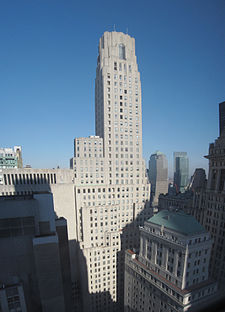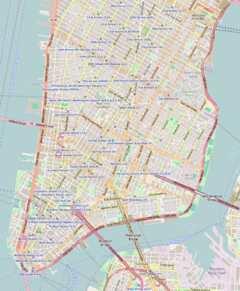1 Wall Street
| 1 Wall Street | |
|---|---|
 1 Wall Street from east in 2010 | |
| General information | |
| Status | Completed |
| Type | Commercial Office |
| Architectural style | art deco |
| Location | 1 Wall St., New York, NY 10286, United States |
| Coordinates | 40°42′26″N 74°00′42″W / 40.70722°N 74.01167°W |
| Construction started | 1929 |
| Completed | 1931 |
| Owner | Macklowe Properties |
| Height | |
| Roof | 654 feet (199 meters) |
| Technical details | |
| Floor count | 50 |
| Floor area | 1,165,645 sq ft (108,292.0 m2)[1] |
| Design and construction | |
| Architect(s) | Ralph Walker |
| External videos | |
|---|---|
 | |
One Wall Street (originally the Irving Trust Company Building, then the Bank of New York Building after 1988, and now known as the BNY Mellon Building since 2007), is an Art-Deco-style skyscraper in Lower Manhattan, New York City. It is located in Manhattan's Financial District on the corner of Wall Street and Broadway. Up until September 30, 2015, it served as the global headquarters of The Bank of New York Mellon Corporation. In May, 2014, the bank sold the building to a joint venture led by Harry B. Macklowe's Macklowe Properties for $585 million.[2]
Architecture
Designed by Ralph Walker, the building was originally built for the Irving Trust Company. It is an Art Deco architectural style, with a steel skeleton whose facade is covered in limestone.[3] Because of the curves in the wall, the bank does not completely occupy its full building lot. By municipal law, unoccupied and unmarked land would revert to the public, which is the reason for a number of small markers embedded in the sidewalk asserting the limits of the building's lot. It counts fifty stories (originally planned for 46),[4] stands 654 feet (199 meters) tall, and measures 1,165,659 rentable square feet.

The Wall Street entrance leads into a two-story banking hall whose ceiling is decorated with red and gold mosaics designed by Hildreth Meiere, comparable to the mosaics in the Golden Hall of Stockholm City Hall, and manufactured by the same company, the Ravenna Mosaic Company in Berlin.[5]
History
The previous high-rise on this corner, also called One Wall Street, was erected in 1907 as a slender 18-story office building. The investors, a syndicate from St. Louis, headed by Festus Wade of the St Louis Mercantile Trust Company, paid $700,000 for the 1,131 square foot property, before construction costs.[6] The architects were Barnett, Haynes & Barnett of St. Louis.[7][8] Known as the "Chimney Building"[6] or "Chimney Corner",[4] it was acquired and razed as part of Irving Trust's real estate consolidation around 1929. Irving Trust was then known as American Exchange Irving Trust, and it bought the original corner property along with a number of adjacent lots on either side, to create a 180 foot frontage along Broadway, and the entire block along Wall Street.[4] The "chimney" property was at that time the costliest transaction per square foot recorded in the city, at $1,050,000.
Construction on the present building began in 1929 and was completed in 1931,[9] to the designs of the architectural firm of Voorhees, Gmelin and Walker. A time study of the construction was photographed form the vantage point of the Trinity Court Building a block away.[10]
Between 1963 and 1965,[9] a 36-floor addition to the site was constructed to the south of the tower to provide extra office space. This site had been occupied by the eighteen-story Manhattan Life Insurance Building (1894), which was the title-holder as the tallest building in the world from 1894 until 1899,[11] and the twenty-two story Knickerbocker Trust Company Building (1909). Among other alterations was the chiseling out of "Irving Trust" name from the cornerstone and replacement with "Bank of New York." The last owner of the Chimney Building, the Central Union Trust Company, had also owned the Manhattan Life building, and had moved there in 1929 upon the sale to Irving.[4]
The building has had numerous problems with the limestone exterior, and in 2001, the building's owners decided to bring in Hoffmann Architects to conduct a survey of the exterior and provide a five-year masterplan consisting of mortar repair and window replacements.
After the sale to Macklowe Properties, it was reported that the building would be converted to condominiums, rental apartments, and retail space.[12]
See also
- List of tallest buildings in New York City
- National Register of Historic Places listings in New York County, New York
- List of New York City Designated Landmarks in Manhattan
References
- ^ "One Wall Street". Skyscraper Center. CTBUH. Retrieved 11 September 2017.
- ^ Levitt, David M (May 22, 2014). "BNY Mellon Reaches Deal for $585 Million Office Sale". Bloomberg.
- ^ Columbia class text
- ^ a b c d "News of Bankers and Banks". Brooklyn Eagle. 1928-05-02. Retrieved 2018-04-30 – via Newspapers.com
 .
.
- ^ NYU class description
- ^ a b "Sale of Chimney Building Plot Recalls Ownership of Late Benjamin D. Silliman". Brooklyn Eagle. 1928-02-09. Retrieved 2018-04-30 – via Newspapers.com
 .
.
- ^ "When Downtown Real Estate Turned Upward". New York Times. Retrieved 26 April 2018.
- ^ Number One Wall Street. Real Estate Record and Builders' Guide, Volume 77. 16 June 1906. p. 1140. Retrieved 26 April 2018.
- ^ a b New York City Landmarks Preservation Commission "One Wall Street Designation Report" (March 6, 2001)
- ^ "Irving Trust Building, New York | Canadian Centre for Architecture (CCA)". Archived from the original on 2010-09-14. Retrieved 2010-02-04.
{{cite web}}: Unknown parameter|dead-url=ignored (|url-status=suggested) (help) - ^ Korom, Joseph A. (2008). The American skyscraper, 1850-1940: a celebration of height. Branden Books. p. 432. ISBN 978-0-8283-2188-4.
- ^ http://ny.curbed.com/archives/2014/11/20/macklowe_to_convert_one_wall_street_into_condos_and_rentals.php
External links
- Building Website
- in-Arch.net: The Irving Trust Co. Building
- Rare slideshow of images showing the construction of the Irving Trust Building - "Irving Trust Building, New York | Canadian Centre for Architecture (CCA)". Archived from the original on 2010-09-14. Retrieved 2010-02-04.
{{cite web}}: Unknown parameter|dead-url=ignored (|url-status=suggested) (help)



